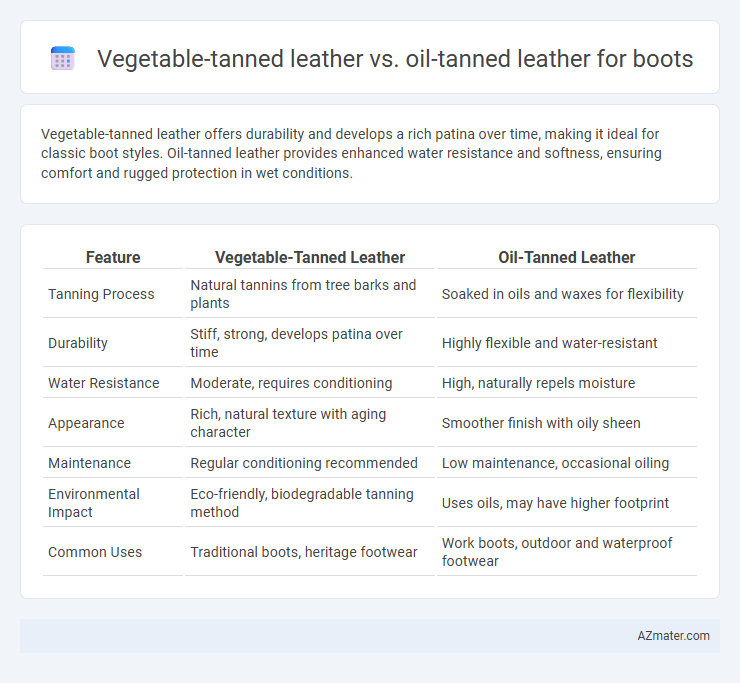Vegetable-tanned leather offers durability and develops a rich patina over time, making it ideal for classic boot styles. Oil-tanned leather provides enhanced water resistance and softness, ensuring comfort and rugged protection in wet conditions.
Table of Comparison
| Feature | Vegetable-Tanned Leather | Oil-Tanned Leather |
|---|---|---|
| Tanning Process | Natural tannins from tree barks and plants | Soaked in oils and waxes for flexibility |
| Durability | Stiff, strong, develops patina over time | Highly flexible and water-resistant |
| Water Resistance | Moderate, requires conditioning | High, naturally repels moisture |
| Appearance | Rich, natural texture with aging character | Smoother finish with oily sheen |
| Maintenance | Regular conditioning recommended | Low maintenance, occasional oiling |
| Environmental Impact | Eco-friendly, biodegradable tanning method | Uses oils, may have higher footprint |
| Common Uses | Traditional boots, heritage footwear | Work boots, outdoor and waterproof footwear |
Introduction to Vegetable-Tanned vs Oil-Tanned Leather
Vegetable-tanned leather is crafted using natural tannins from tree bark, producing a firm, durable material that develops a rich patina over time, ideal for boots requiring longevity and character. Oil-tanned leather involves the infusion of oils and waxes, resulting in a softer, more water-resistant boot surface that resists cracking and offers enhanced flexibility. Understanding the tanning process differences helps in selecting the right boot leather for specific needs such as durability, maintenance, and aesthetics.
What is Vegetable-Tanned Leather?
Vegetable-tanned leather is crafted using natural tannins derived from tree bark, leaves, and other plant materials, creating a firm and durable hide ideal for boots. This tanning method enhances the leather's breathability and develops a rich patina with use, increasing the boot's character over time. Compared to oil-tanned leather, vegetable-tanned leather offers greater rigidity and a more traditional aesthetic preferred in high-quality, long-lasting footwear.
What is Oil-Tanned Leather?
Oil-tanned leather is a type of leather treated with natural oils, such as fish or vegetable oils, which penetrate the hide during the tanning process to enhance durability and water resistance. This tanning method results in a supple, flexible texture that ages with a rich patina, making it ideal for rugged boots exposed to moisture and rough conditions. Compared to vegetable-tanned leather, oil-tanned leather requires less maintenance and offers superior softness and weatherproofing for everyday wear.
Tanning Processes: Key Differences
Vegetable-tanned leather undergoes a natural tanning process using tannins found in tree bark and plant extracts, resulting in a firm, durable material with a rich patina over time. Oil-tanned leather is treated with oils and waxes, imparting a softer texture, water resistance, and enhanced flexibility ideal for boots exposed to moisture. The key differences lie in the raw material absorption--vegetable tanning relies on prolonged exposure to tannins, while oil tanning infuses oils to condition the leather, affecting color, texture, and durability.
Durability and Longevity Comparison
Vegetable-tanned leather offers exceptional durability due to its dense fiber structure and natural tanning process, which enhances its resistance to wear and aging, making it ideal for long-lasting boots. Oil-tanned leather, infused with oils and waxes, provides superior water resistance and flexibility but may develop surface cracks over time with heavy use, potentially reducing its longevity compared to vegetable-tanned leather. While both types ensure sturdy boot construction, vegetable-tanned leather generally outperforms in durability and long-term resilience under rugged conditions.
Water Resistance: Which Leather Performs Better?
Oil-tanned leather offers superior water resistance compared to vegetable-tanned leather due to its impregnation with natural oils that create a hydrophobic barrier. While vegetable-tanned leather absorbs moisture more readily and requires regular treatment with waterproofing agents, oil-tanned leather maintains flexibility and durability even in wet conditions. For boots exposed to frequent water contact, oil-tanned leather provides enhanced protection and longevity.
Comfort and Break-In Period
Vegetable-tanned leather boots offer a firm structure that molds gradually to the foot, requiring a longer break-in period but providing a customized, durable fit over time. Oil-tanned leather boots are softer from the start, delivering immediate comfort with minimal break-in, thanks to their high-fat content that retains suppleness and water resistance. Choosing between the two depends on prioritizing a personalized fit and durability (vegetable-tanned) versus instant comfort and flexibility (oil-tanned).
Appearance and Aging Over Time
Vegetable-tanned leather exhibits a natural, earthy tone with a firm texture that develops a rich patina and deepens in color over time, reflecting its exposure to sunlight and oils. Oil-tanned leather features a softer, more supple surface with a slightly oily finish that enhances water resistance and gains character through subtle darkening and a smoother, worn-in appearance. Both types age distinctly: vegetable-tanned leather shows more visible creasing and color shifts, while oil-tanned leather maintains flexibility and a consistent hue with gentle surface marks.
Eco-Friendliness and Sustainability
Vegetable-tanned leather uses natural tannins from tree bark and plant extracts, making it biodegradable and eco-friendly compared to chrome-tanned alternatives. Oil-tanned leather, treated with oils like mink or fish oil, enhances water resistance while maintaining a more natural tanning process that reduces chemical waste. Both methods favor sustainability, but vegetable tanning is often preferred for lower environmental impact due to its renewable tannins and minimal use of synthetic substances.
Choosing the Best Leather for Your Boots
Vegetable-tanned leather offers a firm, structured feel with natural aging and develops a rich patina over time, making it ideal for boots that require durability and classic aesthetics. Oil-tanned leather provides superior water resistance and softness, ensuring comfort and protection in wet or rugged conditions, which is beneficial for outdoor and work boots. Choosing the best leather depends on your priorities: opt for vegetable-tanned for longevity and traditional style, or oil-tanned for flexibility and enhanced weather resistance.

Infographic: Vegetable-tanned leather vs Oil-tanned leather for Boot
 azmater.com
azmater.com